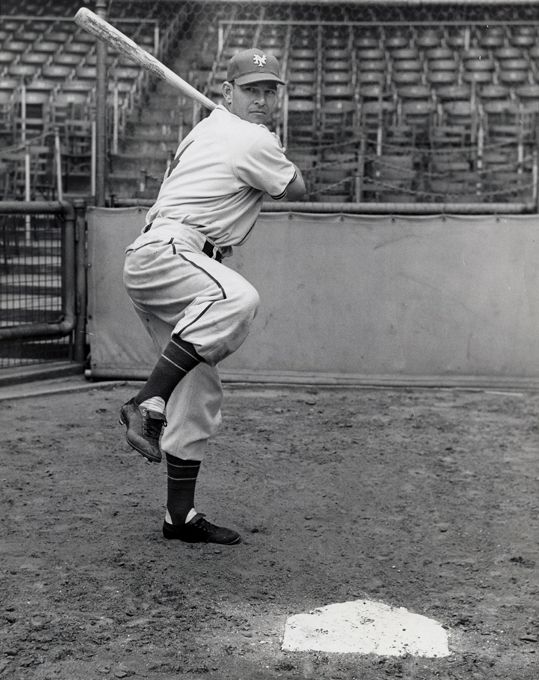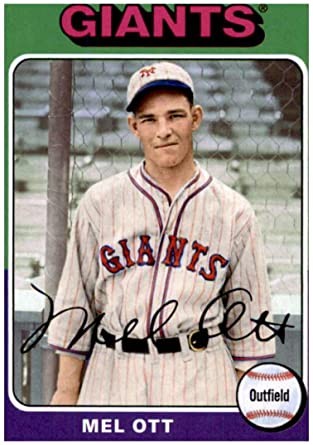On March 2, 1909, a 12-pound baby boy was born in Gretna who would put his hometown on the map of major league baseball forever. The Hall of Famer achieved records that are still current today. Melvin Thomas Ott, nicknamed “Master Melvin” in the sports arena was an amazing professional baseball right-fielder fondly remembered as Mel Ott.
He never played in the minor league, but so gifted, went straight to the major league. He batted left-handed and threw right-handed, played his entire career for the New York Giants from 1926 through 1947.
As a 17-year-old “Boy Wonder” in 1926, his size belied his power. He was only 5’ 9” tall and weighed in at 170 pounds, unusually slight in stature for a power hitter, but led the National League (NL) in home runs a then-record six times. He was an All-Star for 11 consecutive seasons and the first NL player to surpass 500 career home runs. He was elected to the National Baseball Hall of Fame in 1951.
His family, including his parents Charles and Caroline Ott, older sister, Marguerite and younger brother, Charles, resided at 422 Newton Street. He was never referred to as Mel, but always called Melvin by the family.
Baseball seemed a part of his DNA. Some said he reached kindergarten and baseball at the same time. He played baseball in the parks and sandlots around town, usually with older boys. Mel attended Gretna Primary School, recognized early on as a gifted athlete, a prodigy. His natural swing and high leg kick remained his professional trademark throughout his career.
His father and uncles played baseball for semi-professional teams, so young Melvin spent many happy hours at the baseball field. His father did a lot of activities with him, fishing being a favorite where they would stop fishing to throw a few balls together. His Uncle, “Moo Cow” Miller who worked for a dairy was an excellent pitcher who threw his nephew every kind of pitch possible. Melvin mastered the art of batting, eventually hitting everything thrown at him!

Despite his short stature he quickly established himself as a gifted athlete, especially in baseball. During his high school years at McDonogh-Jefferson High, he also played on a semi-pro team three or four days a week. He already showed considerable power at a young age while getting paid for it. His team had a tradition of passing the hat whenever a player hit a home run that earned a victory, so he was earning money for playing baseball as early as 14.
The New Orleans Pelicans, his minor league hometown team refused to sign him because of his size. Ott took a job in Patterson, near Morgan City, Louisiana where he became the star of his company baseball team. The owner of the lumber company, Henry Williams was very impressed with Ott. While visiting New York, Williams suggested that renowned Giants manager John McGraw give Ott a tryout. Williams bought the slugger a train ticket to New York.
Ott arrived in New York in early September 1925. So impressed was McGraw with his batting that he formally signed Ott to a contract in January.
Aiming at a hit for power, Ott used a batting style that was then considered unorthodox, lifting his forward, right foot prior to impact. When McGraw first saw his style, he called it “the most natural swing I’ve seen in years.” McGraw predicted that Ott would be one of the greatest left hand hitters ever in the National League, but converted him to an outfielder because he thought Ott too small to be a major league catcher that he had been playing. After two years of part-time playing, he became the regular right fielder at just 19.
Beyond expectations, Ott powered 41 home runs and collected 151 RBI’s, setting new records for players 20 years-old or younger at the start of the season. He was a six-time NL home run leader who led the Giants in home runs from 1928 to 1945. This 18-season consecutive dominance is a record. No other player has ever led his team in more consecutive years in a single Triple Crown category!
He was both the youngest player to hit 100 home runs and the first National Leaguer to hit 500 home runs. He passed Rogers Hornsby to become the all-time NL home run leader in 1937, holding that title until Willie Mays passed him in 1966.
Because of his power hitting, he was noted for reaching base via BB, the base on balls or a walk. He drew five walks in a game three times. He set the NL record for most walks in a doubleheader, with six in 1929 and six again in 1944. He tied an MLB record by drawing a walk in seven consecutive plate appearances in 1943. He also led the NL in walks six times and twice scored six runs in a game. He is the youngest major leaguer to ever hit for the cycle. Ott was the first NL player to post eight consecutive 100-RBI seasons, only four others have since joined him.
In 1943, all of his 18 home runs came at home. Of Ott’s 511 career home runs, 323 of them or 63% came at home. Because of this, his home run record historically has been downplayed, suggesting that a 257-foot foul line at the Polo Grounds, stadiums in Manhattan, resulted in higher numbers at home.
As a balance, the Polo Grounds had the deepest power alleys in baseball. He also hit more career home runs in foreign stadiums than any other NL hitter at the time of his retirement. In some of his better seasons, he hit more homers on the road than in the Polo Grounds.
There may be reason to believe that he was a better hitter than his record suggests because of differences in NL and American League ball specifications. Those differences are considered the most outstanding in the history of the game and made it considerably harder for NL hitters to achieve home runs.

Ott was also a skilled fielder. He was a master at playing balls that bounced off the fences at the Polo Grounds, allowing him to garner 26 assists in 1929, his first full season as a full-time player. He would never even approach that figure again, as baserunners quickly realized it was far too risky to run on balls hit in Ott’s direction.
He played in the World Series in 1933, 1936 and 1937, winning in 1933 where he hit two home runs. In Game 1, he had four hits, including a two-run home run in the first inning. In Game 5, he drove in the series-winning run with two outs in the top of the 10th, driving a pitch into the center-field bleachers.
Playing in 16 World Series games, Ott batted .295 (18-for-61) with eight runs, four home runs and ten RBI. In his 22-season career, he batted .304 with 511 home runs, 1,860 RBIs, 1,859 runs, 2,876 hits, 488 doubles, 72 triples, 89 stolen bases, 1,708 BB, .414 on-base percentage and a .533 slugging average. Defensively, he recorded a .974 fielding percentage. He hit better than .300 ten times in his major league career. At the time of his retirement, he had hit 200 more home runs than the next-highest National Leaguer.
Ott was named player-manager in 1941 and continued as a regular player for another five years, remaining productive at the plate for much of that time. In 1942, he led the league in home runs, runs scored and walks. He finished second in home runs and third in slugging percentage in 1944. In 1945, he hit .308 and finished tied for fourth in home runs.
On the second day of the 1946 season, a day after hitting what would be his final career home run, he injured his knee while diving for a fly ball that effectively ended his career. He only appeared in 29 more games for that season and retired after only four cameo appearances in 1947. He remained manager until Leo Durocher replaced him midway the 1948 season.
The Giants’ best finish during Ott’s tenure was third place in 1942, one of only three times he finished with a winning record. His 1943 and 1944 teams were decimated by World War II with many established players drafted into the military.
Ott spent the remaining two-and-a-half years of his contract helping run the Giants’ “farm system,” minor league teams. In 1951, he took on managing the Oakland Oaks of the Pacific Coast League, leading the club to a 7th place finish. In 1952, they finished 2nd place under Ott.
Mel Ott’s number “4” was retired by the Giants in 1949 and is posted on the facade of the upper deck in the left field corner of Oracle Park. He was elected to the Baseball Hall of Fame in 1951 with 87.2% of the vote.
He was a NL All-Star for 11 consecutive seasons, from 1934 through 1944 with All-Star selections only starting in 1933. He had at least three All-Star caliber seasons prior to that, as he had in 1945 when MLB cancelled the 1945 contest.

He is one of only six National League players to spend a 20+ year career with one team. In 1999, he ranked number 42 on The Sporting News’ 100 Greatest Baseball Players and was a nominee for the MLB All-Century Team.
Ott spent the 1953 and 1954 seasons out of baseball for the first time since going to New York in 1925. In 1955, he joined the Mutual radio network to recreate baseball games. From 1956 to 1958, Ott teamed to broadcast Detroit Tigers games on radio and television.
Sadly, Mel Ott was badly injured in an auto accident in Bay St. Louis, Mississippi. He was transferred to a hospital in New Orleans where he died a week later on November 21, 1958 at the age of 49. He was interred in Metairie Cemetery.
His granddaughter Dr. Diane Lorio Rose and great-grandson James Brown live in Metairie and some cousins live in Gretna. He was the cousin of Ed Ott and his wife Virgie Ott, both deceased and their daughters Jill and Julie Ott. Bishop Stanley Ott was so proud of his cousin Melvin’s accomplishments that when he became Bishop of the Archdiocese of Baton Rouge, he included a baseball and bat in his personal coat of arms.
Since 1959 the NL has honored the league’s annual home run champion with the Mel Ott Award. In the 1989 movie Field of Dreams, Ott was one of several deceased players portrayed in farmer Ray Kinsella’s Iowa cornfield. In 2006, he was featured on a United States postage stamp, as one of a block of four honoring “Baseball Sluggers.” He is also remembered in the name of the Mel Ott Little League of Amherst, New York.
Mel Ott was a gentle, kind man, simply a really good guy. There was no color barrier for Mel Ott. Another talented Gretna baseball player, J. B. Spenser https://homeplatedon’tmove.wordpress.com/2014/06/29/gretnas-own-j-b-spenser/ went to New York to play ball in the Negro American League. To the delight of Spenser, Ott went to one of Spenser’s games and asked that Spenser meet him later. They shared Gretna stories and went to a dinner together in Harlem.
He is revered and honored in Gretna with his namesake, Mel Ott Park that opened in 1959 and also a fairly new landmark within the park, appropriately named the Mel Ott Recreation Center. There was simply no other name so aptly applicable for the $5,500,000, 20,000 square foot multi-purpose facility that opened in March 2013. His spirit lives on in the stunning life-size bronze statue depicting his hallmark stance in front of the state-of-the-art facility.
Alfred M. Martin wrote a book to honor his childhood hero, “Mel Ott, the Gentle Giant” https://www.amazon.com/Mel-Ott-Gentle-American-History/dp/0810845989 It is a wonderful read about the life of Mel Ott. Some background for this story came from this interesting book.
###




WENDY BEAUMONT
what a nice article for a {large} home grown boy. my daughter dressed as mel for a project @ christ the king school in the 90’s. i worked with his aunt virgie ott @ lerner’s store westside shopping center 1977. she was a pepper {ha ha}.